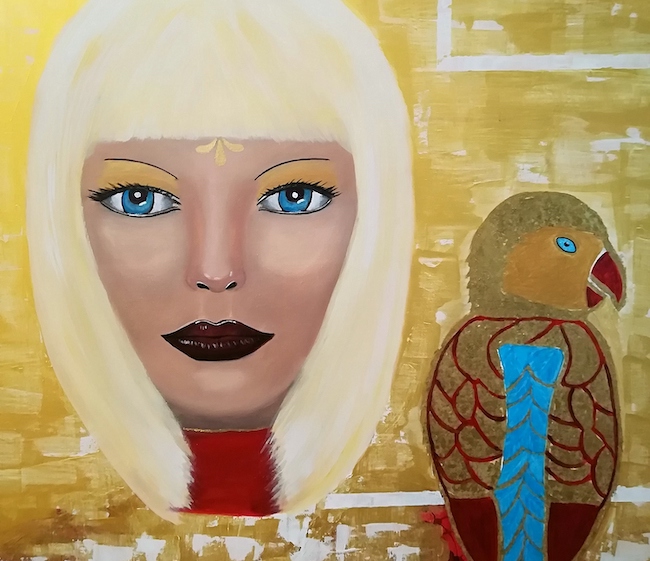Raccontare la donna in tutte le sue sfumature è stato lo scopo, il fine e anche l’ambizione degli artisti di ogni tempo, di tutto quel sensibile mondo maschile affascinato dalla figura femminile al punto di volerne svelare il mistero, la malia e l’ammirazione pur non riuscendo a coglierne la vera essenza. Quando però sono le artiste a decidere di osservare e rappresentare il loro stesso universo attraverso il proprio punto di vista, tutto sembra più chiaro, più profondo, in virtù della spiccata capacità empatica che proprio nel mondo femmineo ha la sua massima espressione. La protagonista di oggi sceglie il ritratto per esortare le donne a prendere coscienza di se stesse e della propria autonomia.
Intorno al primo ventennio del Novecento cominciarono a emergere nel mondo dell’arte figure femminili con forte personalità e determinazione a non restare all’ombra dei colleghi uomini; il loro desiderio di emancipazione passò spesso attraverso difficoltà oggettive ed esistenziali da cui però riuscirono a tirarsi fuori guadagnando un proprio spazio e un linguaggio stilistico singolare e personale che le consacrò alla storia. Non solo, il percorso aperto da grandi personalità come Frida Kahlo e Tamara de Lempicka diede inizio a una nuova fase dell’arte in cui appartenere al sesso femminile non avrebbe più costituito un limite o un ostacolo bensì sarebbe stato riconosciuto come punto di forza per avere un approccio differente, più articolato e orientato ad aspetti reali ed effettivi di quel mondo da sempre esplorato ma mai colto nella sua sostanza. Entrambe le celeberrime artiste del secolo scorso, Kahlo e de Lempicka, scelsero il ritratto come forma narrativa e anche come modalità prediletta per esprimere e interpretare sensazioni ed emozioni personali e intime, nel caso della prima, oppure estetiche e orientate al bel vivere nel caso della seconda; nelle opere delle due ritrattiste emerge la totale assenza di quel mistero molto spesso inseguito ed esplorato dagli artisti uomini, e prende spazio invece la trasparenza, la spontaneità e la profondità del sentire che troppo spesso erano state confuse o idealizzate come espressioni enigmatiche di una spiritualità platonica. La concretezza dello sguardo delle artiste ha riproposto la donna nella sua veste di essere umano, con pregi e difetti, con sofferenze e battaglie da combattere, spazi da conquistare in un mondo ancora troppo appannaggio dell’uomo; il cammino di quelle due pioniere del Novecento è stato poi battuto anche da Margareth Keane che a sua volta è stata costretta, o forse sarebbe meglio dire convinta a farlo, a permettere al marito di appropriarsi della paternità delle meravigliose opere che hanno affascinato il mondo dell’arte statunitense e che solo dopo molti anni ha trovato il coraggio di svelare l’autorialità di tutte le tele attribuite a Walter Keane. Verena Maria Krutzler, in arte Verena Maria, sceglie a sua volta di ritrarre e narrare il mondo femminile attraverso uno stile a metà tra Art Déco e Pop Surrealismo attraverso cui l’artista vuole affermare l’importanza del ruolo della donna nella società contemporanea e al tempo stesso esortarla a credere di più in se stessa, nella sua capacità riflessiva e nella sua indipendenza, troppo di frequente perduta all’interno di convinzioni imposte dalle basi culturali in cui cresce.
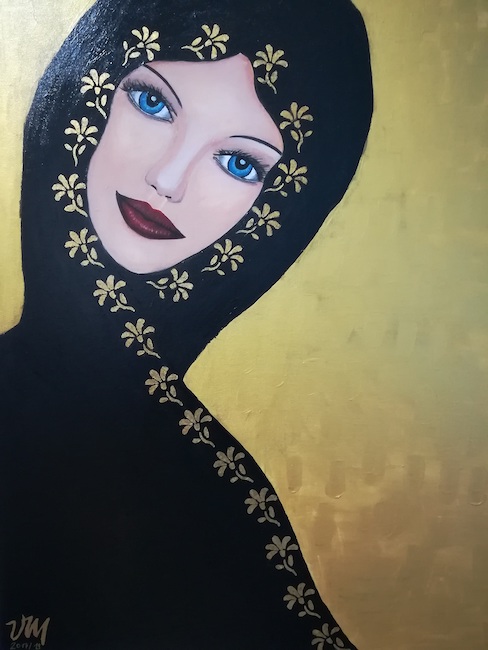
Prendere in mano la propria esistenza, apprendere a conquistarsi il proprio posto nel mondo, scegliere di non dipendere né economicamente né emotivamente da nessuno se non da se stessa, sono i suggerimenti che Verena Maria desidera far trapelare dalle sue opere, incoraggiamento al mondo femminile ad attingere alla determinazione di tante grandi donne del passato e trasformarla in linfa per vivere il complicato presente attuale, dove tutto ciò che è al di fuori dell’individuo diventa gradualmente più incerto rendendo così necessario un percorso introspettivo e di autoconsapevolezza.
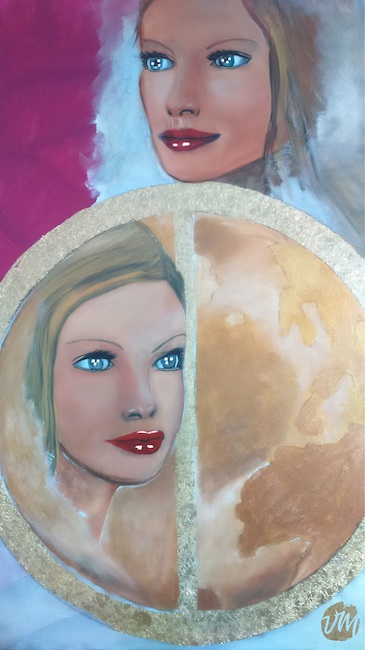
Nella tela Himmel und Erde (Paradiso e terra) Verena Maria sottolinea quanto sia importante la forza interiore e l’atteggiamento positivo in virtù del quale non è necessario sollevarsi dalla contingenza e dalla concretezza per stare bene con se stessi. La protagonista infatti presenta la medesima espressione, il medesimo sorriso in entrambi i casi perché sa che è solo il suo approccio, il suo sguardo sulle cose e sugli eventi a poter fare la differenza; la luminosità delle tonalità scelte enfatizza ancor più questo concetto attraverso cui l’artista manifesta e racconta l’importanza di un punto di visa positivo e propositivo.
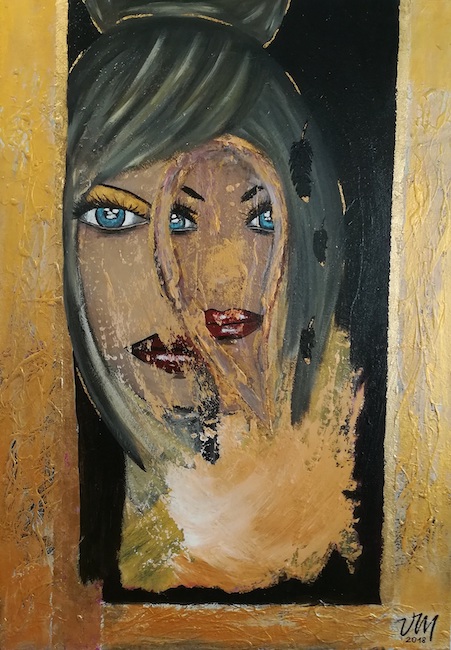
In Spiegelbild (Immagine riflessa) Verena Maria mette in luce la necessità di effettuare un percorso introspettivo, di andare a fondo a tutto ciò che si nasconde dietro l’immagine mostrata al mondo esterno e mettersi a nudo per comprendere le sensazioni e le pulsioni intime, quelle che devono essere protette ma non fino al punto di fingere che non esistano; in questa tela le tonalità sono più scure, più ombrose, in accordo con l’esigenza di raccoglimento e di riflessione funzionali a entrare in una dimensione spirituale, meditativa, di connessione con una parte interiore che ha bisogno di essere guardata con coraggio per essere affrontata, per essere portata alla luce e compresa.
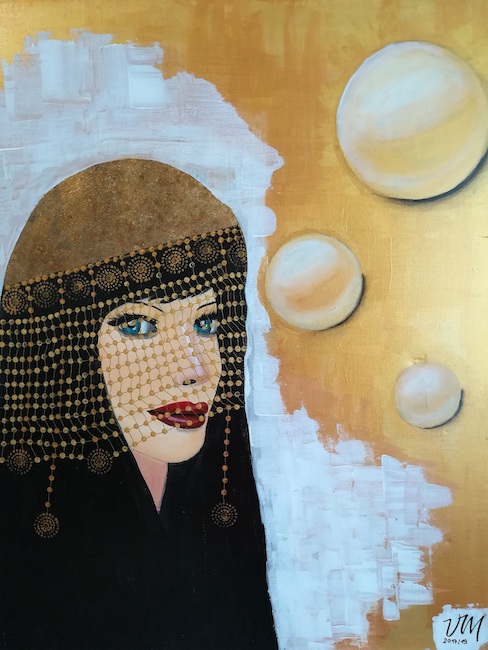
Emerge sempre la difficoltà della donna di mostrare la propria vera essenza nelle opere di Verena Maria, come se ciò che osserva intorno a se fosse una costante conferma del velato timore da parte del mondo femminile di non essere accettato nella sua interezza, come se fosse indispensabile celare tutto ciò che in qualche modo potrebbe essere frainteso o non conforme alle regole silenziose della società; l’invito dell’artista è invece di liberarsi dalle gabbie di schemi e di canoni prestabiliti per avere il coraggio di smettere di nascondere il lato più vero, più temerario, e anche più fragile perché la sfida è esattamente quella di apprendere a tutelarlo senza per questo riporlo in silenzio in un angolo dell’interiorità. La leggerezza elegante dello stile pittorico non compromette dunque la profondità del messaggio e dei significati che avvicinano il linguaggio di Verena Maria alla dimensione surrealista per la capacità di collocare le sue protagoniste in un non spazio, in una realtà sospesa e modificata in cui tutto è possibile perché tutto è decontestualizzato.
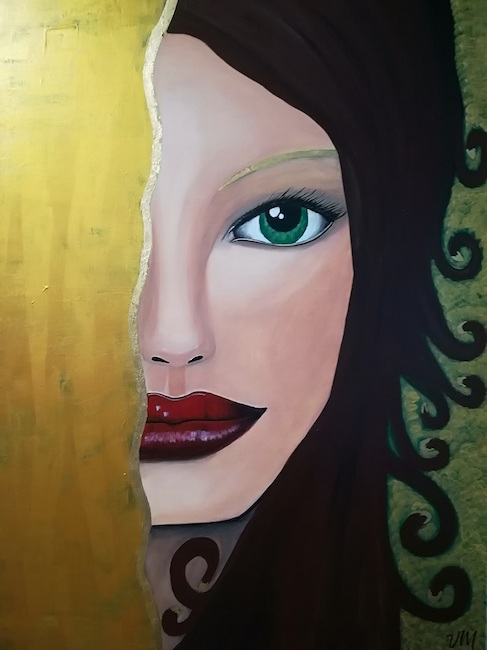
Elemento comune a tutte le tele è la presenza dell’oro, come nell’opera Vorhang auf (Dietro la tenda), attraverso il quale l’artista suggerisce al mondo femminile di non rinunciare ai propri sogni, di non smettere mai di desiderare e di guadagnarsi quel senso di indipendenza e autonomia che scaturiscono nel momento in cui viene perseguito un obiettivo, realizzato un sogno, raggiunta una meta in grado di infondere una maggiore sicurezza, la consapevolezza di riuscire a stare in piedi sulle proprie gambe senza aver bisogno di un appoggio esterno che, proprio in virtù di quella presa di coscienza, si incontrerà solo quando non sarà più un bisogno bensì una scelta.
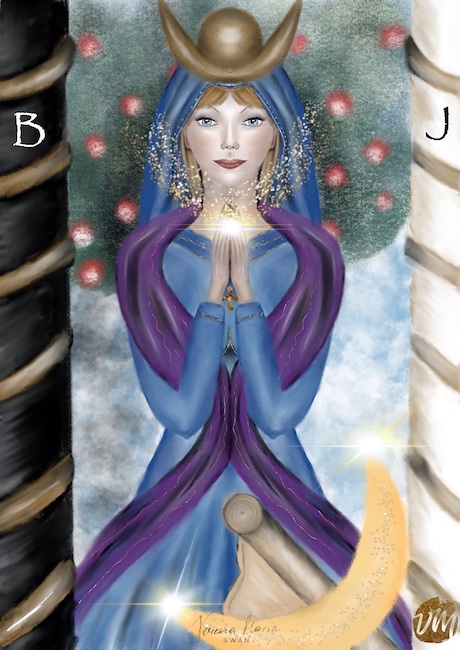
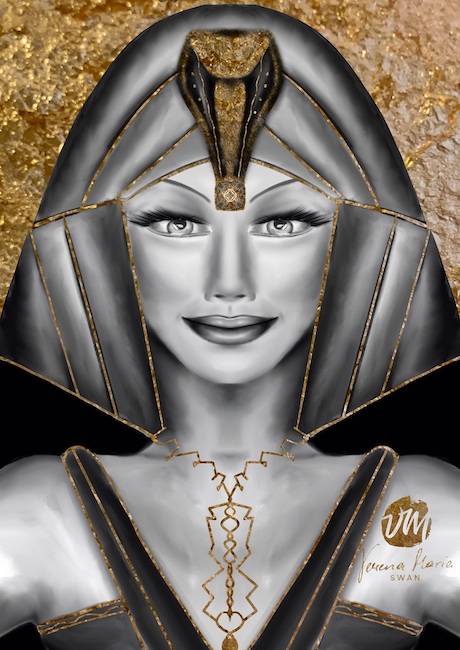
Verena Maria non è solo pittrice, esegue anche illustrazioni digitali che vengono per lo più utilizzate per essere riprodotte su mazzi di carte; anche in questo caso la donna è assoluta protagonista di un mondo fantastico, in cui tutto è stilizzato eppure completamente legato alla presenza di quella forza, di quell’orgoglio femminile che non può non emergere dalla raffigurazione che l’artista ne fa. Verena Maria espone regolarmente in tutto il territorio austriaco.
VERENA MARIA-CONTATTI
Email: office@verenamaria.com
Sito web: www.verenamaria.com
Facebook: https://www.facebook.com/profile.php?id=100011310224705
Instagram: https://www.instagram.com/verenamariaart/
The celebration of the unconscious strength of women in Verena Maria’s portraits
Telling the story of women in all their nuances has been the aim, the purpose and also the ambition of artists throughout the ages, of that sensitive male world fascinated by the female figure to the point of wanting to reveal its mystery, its enchantment and admiration, even though they are unable to grasp its true essence. However, when female artists decide to observe and represent their universe through their own point of view, everything seems clearer, more profound, by virtue of the marked empathic capacity that has its greatest expression in the female world. Today’s protagonist chooses the portrait to exhort women to become aware of themselves and their autonomy.
Around the first two decades of the twentieth century, female figures began to emerge in the art world with strong personalities and a determination not to remain in the shadow of their male colleagues. Their desire for emancipation often passed through objective and existential difficulties from which, however, they managed to pull themselves out, gaining their own space and a unique and personal stylistic language that consecrated them to history. Not only that, the path opened up by great personalities such as Frida Kahlo and Tamara de Lempicka initiated a new phase in art in which belonging to the female sex would no longer constitute a limitation or an obstacle but would be recognised as a point of strenght for having a different approach, more articulated and oriented towards real and effective aspects of that world always explored but never grasped in its substance. Both the famous artists of the last century, Kahlo and de Lempicka, chose the portrait as a narrative form and also as their preferred way of expressing and interpreting personal and intimate sensations and emotions in the case of Kahlo, or aesthetic and lifestyle-oriented in the case of de Lempicka; in the works of the two portrait artists, there emerges a total absence of the mystery so often pursued and explored by male artists, and there is instead a transparency, spontaneity and depth of feeling that had too often been confused or idealised as enigmatic expressions of a platonic spirituality.
The concreteness of the artists’ gaze has re-proposed the woman as a human being, with merits and defects, with sufferings and battles to fight, spaces to conquer in a world still too much prerogative of men; the path of these two twentieth-century pioneers was also followed by Margareth Keane, who in turn was forced, or perhaps it would be better to say persuaded, to allow her husband to appropriate the paternity of the marvellous artworks that have fascinated the American art world and who only after many years she found the courage to reveal the authorship of all the paintings attributed to Walter Keane. Verena Maria Krutzler, aka Verena Maria, chooses to portray and narrate the world of women in a style halfway between Art Deco and Pop Surrealism, through which the artist wishes to affirm the importance of the role of women in contemporary society and at the same time urge them to believe more in themselves, in their capacity for reflection and in their independence, which is all too often lost within the convictions imposed by the cultural bases in which they grow up. Taking control of one’s own existence, learning to conquer one’s own place in the world, choosing not to be financially or emotionally dependent on anyone but oneself: these are the suggestions that Verena Maria wishes to convey in her paintings, encouraging the female world to draw on the determination of so many great women of the past and transform it into the lifeblood for living in today’s complicated present, where everything outside the individual gradually becomes more uncertain, thus making it necessary to undertake a path of introspection and self-awareness. In the painting Himmel und Erde (Heaven and Earth) Verena Maria emphasises the importance of inner strength and the positive attitude by virtue of which it is not necessary to rise above contingency and concreteness in order to feel good about oneself. In fact, the protagonist has the same expression and the same smile in both cases because she knows that it is only her approach, her view of things and events that can make the difference; the brightness of the colours chosen emphasises this concept even more, through which the artist expresses and narrates the importance of a positive and proactive point of view.
In Spiegelbild (Reflected Image), Verena Maria highlights the need to undertake an introspective journey, to get to the bottom of everything that is hidden behind the image shown to the outside world and to lay bare to understand intimate feelings and impulses, those that must be protected, but not to the point of pretending they do not exist; in this canvas the tones are darker, shadier, in accordance with the need for recollection and reflection, functional to entering into a spiritual, meditative dimension, of connection with an inner part that needs to be looked at with courage in order to be faced, to be brought to light and understood. The woman’s difficulty in showing her true essence always emerges in Verena Maria’s artworks, as if what she observes around her is a constant confirmation of the veiled fear on the part of the female world of not being accepted in its entirety, as if it were essential to conceal everything that might somehow be misunderstood or not conform to the silent rules of society; The artist’s invitation is instead to free oneself from the cages of schemes and pre-established canons in order to have the courage to stop hiding one’s truest, most daring, and also most fragile side, because the challenge is precisely that of learning to protect it without silently storing it in a corner of one’s interiority. The elegant lightness of the pictorial style does not therefore compromise the depth of the message and meanings that bring Verena Maria’s language closer to the surrealist dimension through her ability to place her protagonists in a non-space, in a suspended and modified reality in which everything is possible because everything is decontextualised. A common element in all the canvases is the presence of gold, as in the painting Vorhang auf (Behind the Curtain), through which the artist suggests to the female world that it should not give up on its dreams, that it should never stop desiring and that it should gain the sense of independence and autonomy that arise when a goal is pursued, when a dream is realised, a destination is reached, that instils a greater sense of security, the awareness of being able to stand on one’s own two feet without needing external support, which, precisely because of this realisation, will only be encountered when it is no longer a need but a choice. Verena Maria is not only a painter, she also does digital illustrations that are mostly used to be reproduced on packs of cards; in this case too, the woman is the absolute protagonist of a fantasy world, in which everything is stylised yet completely linked to the presence of that strength, that feminine pride that cannot fail to emerge from the artist’s depiction of it. Verena Maria regularly exhibits throughout Austria.
VERENA MARIA-CONTACTS
Email: office@verenamaria.com
Website: www.verenamaria.com
Facebook: https://www.facebook.com/profile.php?id=100011310224705
Instagram: https://www.instagram.com/verenamariaart/


